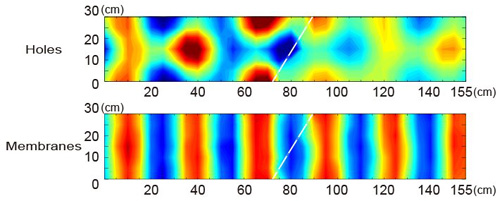
In collaboration with Profs. Sam Hyeon Lee and Kong-ju Bock Lee together with coworkers in South Korea, we have devised a way to make hard walls transmit sound almost perfectly. This could prove useful for developing new types of acoustic windows or concentrators.
Solid walls do not normally transmit sound very well. Even if you open a few small holes here or there, the transmission is still poor. We show that, counterintuitively, if you stretch membranes across the holes, sound of the right frequency transmits almost perfectly.
We have experimentally demonstrated this using kitchen cling film for the membranes. Images of the sound pressure distribution in a duct blocked by a wall with small holes with and without the membranes are shown below.

Upper image: pressure map at 1.2 kHz for 4 small holes in a rigid perspex plate with no membranes, showing poor transmission. Lower image: 4 tight membranes are installed in the holes in the plate, showing excellent transmission. Only 3% of the area is covered by the holes.
Sound is incident at a slanting angle on the wall. If there are no membranes, the sound is almost all reflected and produces a characteristic interference pattern. With membranes installed in the holes the sound transmits without reflection. We have shown that this works for any angle of incidence.
We also find a giant acoustic concentration, by a factor of up to 5700 in intensity, inside the holes.
A tiny force from the sound wave is sufficient to launch a large motion of the membrane, as if the air in the hole were moving with zero mass. This is responsible for this 'extraordinary transmission'.
Materials with tailored structure on tiny length scales are called metamaterials, and show strange properties such as invisibility. Invisibility for multiple angles of incidence has previously only been demonstrated for electromagnetic metamaterials. Our zero-mass acoustic metamaterial achieves this at audio frequencies.
This invisible wall could be used for security glass that allows you to talk across it while protecting you from any mechanical intrusion. It also could be used to concentrate acoustic energy through a tiny hole, forming a novel lens for sub-wavelength-resolution imaging. See 'Giant acoustic concentration and extraordinary transmission in zero-mass metamaterials, ' J. J. Park et al., Phys. Rev. Lett. 110, 244302, 2013, or news articles in Nature or other journals.